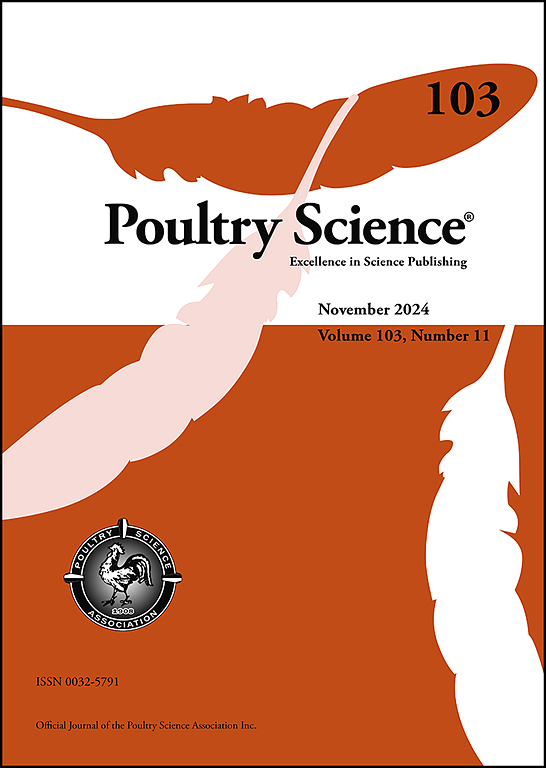Continued presence of enrofloxacin residues in feathers of broiler parent stock based on quantitative UHPLC-MS/MS detection
IF 3.8
1区 农林科学
Q1 AGRICULTURE, DAIRY & ANIMAL SCIENCE
引用次数: 0
Abstract
Fluoroquinolones (FQ) are critically important antimicrobials. When broilers are treated with FQs, residues of these compounds can accumulate in their feathers, posing potential risks if feathers are repurposed, such as for use in animal feed. The aim of this study was to determine the residue depletion profiles of enrofloxacin (ENR) and its metabolite ciprofloxacin (CIP) in broiler parent stock feathers by using a sensitive UHPLC-MS/MS method. The total antibiotic residue concentration was determined. An experimental study was conducted with a treatment group and a control group. In the treatment group, fifty broiler parent stock were administered ENR for three consecutive days at 22.5 weeks of age, with four individual feathers analysed per animal at different timepoints after administration. After 15 weeks, all animals had ENR and CIP concentrations above the limit of quantification (LOQ) of 5 ng/g feather. ENR concentrations remained relatively stable throughout the observation period. For CIP, an initial rapid decline in concentration was observed, followed by a steady-state phase. Additionally, CIP concentrations were considerably lower than those of ENR. For both ENR and CIP the within-animal variance in residue levels was higher than the variability in mean residue levels across different animals sampled at the same timepoint. In conclusion, ENR and CIP demonstrate high stability in broiler parent stock feathers and can be detected for at least 15 weeks post-treatment. These findings highlight the persisting nature of FQ residues in feathers, underscoring the need for caution when considering the reuse of feathers in agricultural or industrial applications to prevent the development of antimicrobial resistance.
基于UHPLC-MS/MS定量检测的肉鸡亲本羽毛中持续存在恩诺沙星残留
氟喹诺酮类药物(FQ)是非常重要的抗菌剂。当肉鸡用FQs处理时,这些化合物的残留物会积聚在它们的羽毛中,如果羽毛被重新利用,例如用于动物饲料,就会造成潜在的风险。采用高效液相色谱-质谱联用技术(UHPLC-MS/MS)测定恩诺沙星(ENR)及其代谢产物环丙沙星(CIP)在肉鸡亲本母猪羽毛中的残留损耗谱。测定抗生素总残留浓度。采用治疗组和对照组进行实验研究。在治疗组,50只肉鸡亲本在22.5周龄时连续3天给予ENR,在给药后的不同时间点对每只鸡的4根羽毛进行分析。15周后,所有动物的ENR和CIP浓度均超过5 ng/g羽毛的定量限(LOQ)。ENR浓度在整个观测期内保持相对稳定。对于CIP,最初的浓度快速下降,随后是一个稳态阶段。此外,CIP浓度明显低于ENR。对于ENR和CIP,动物内残留水平的变异高于同一时间点采样的不同动物的平均残留水平的变异。综上所述,ENR和CIP在肉鸡母畜羽毛中具有较高的稳定性,至少在处理后15周内可以检测到。这些发现强调了羽毛中FQ残留物的持久性,强调了在考虑在农业或工业应用中重复使用羽毛以防止抗菌素耐药性发展时需要谨慎。
本文章由计算机程序翻译,如有差异,请以英文原文为准。
求助全文
约1分钟内获得全文
求助全文
来源期刊

Poultry Science
农林科学-奶制品与动物科学
CiteScore
7.60
自引率
15.90%
发文量
0
审稿时长
94 days
期刊介绍:
First self-published in 1921, Poultry Science is an internationally renowned monthly journal, known as the authoritative source for a broad range of poultry information and high-caliber research. The journal plays a pivotal role in the dissemination of preeminent poultry-related knowledge across all disciplines. As of January 2020, Poultry Science will become an Open Access journal with no subscription charges, meaning authors who publish here can make their research immediately, permanently, and freely accessible worldwide while retaining copyright to their work. Papers submitted for publication after October 1, 2019 will be published as Open Access papers.
An international journal, Poultry Science publishes original papers, research notes, symposium papers, and reviews of basic science as applied to poultry. This authoritative source of poultry information is consistently ranked by ISI Impact Factor as one of the top 10 agriculture, dairy and animal science journals to deliver high-caliber research. Currently it is the highest-ranked (by Impact Factor and Eigenfactor) journal dedicated to publishing poultry research. Subject areas include breeding, genetics, education, production, management, environment, health, behavior, welfare, immunology, molecular biology, metabolism, nutrition, physiology, reproduction, processing, and products.
 求助内容:
求助内容: 应助结果提醒方式:
应助结果提醒方式:


